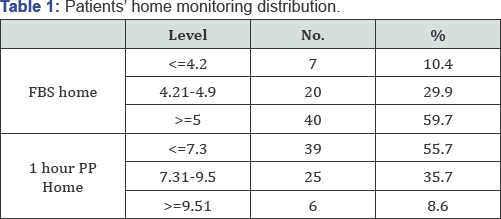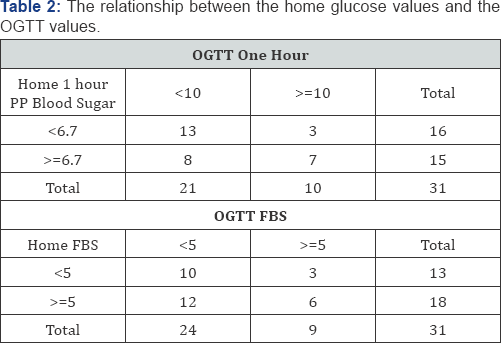Home Blood Glucose Monitoring in Pregnancy and its Relation to OGTT and Pregnancy Outcome
Latifa Baynouna*
Ambulatory Health Care Services, UAE
Submission: July 03, 201 ; Published: July 21, 2017
*Corresponding author: Latifa Baynouna, Ambulatory Health Care Services, Abu Dhabi, UAE, Email: latifa.mohammad@gmail.com
How to cite this article: Latifa B. Home Blood Glucose Monitoring in Pregnancy and its Relation to OGTT and Pregnancy Outcome. J Gynecol Women's Health 2017; 6(1): 555680. DOI: 10.19080/JGWH.2017.06.555680.
Abstract
Influence of glucose level on pregnancy outcome was well studied. This study describes blood glucose home monitoring of pregnant Emirati women and its association with OGTT and pregnancy outcome.
Method: Seventy-five non-diabetic low risk mid-trimester pregnant women were randomly recruited and followed prospectively for pregnancy and delivery related outcomes.
Results: raised home one-hour postprandial blood glucose readings were significantly associated with complicated deliveries (t-test; p<0.004). Additionally, home monitoring values showed no correlation with the OGTT values.
Conclusion: Home monitoring performed well in predicting adverse outcome in this population and had no correlation with the OGTT
Keywords: Blood glucose; Pregnancy; OGTT; Home monitoring; Pregnancy outcome
Introduction

Hyperglycaemia may result in adverse pregnancy outcomes. These outcomes are occurring from early trimester to later pregnancy, delivery, postnatal and later on child life [1-6]. Preventing these sequelae requires diagnostic test that can identify high-risk women and pregnancies in order to institute a suitable program to manage the hyperglycaemia (Table 1).
OGTT was the test first used to find this correlation between hyperglycaemia and pregnancy outcome [7]. Nevertheless, the use of OGTT was challenged in spite of its high sensitivity and specificity, mainly because it is done once and blood glucose variability is high and depends on many factors. Also adverse outcomes may still occur below standard OGTT cut-off point. Such false reassurance is higher in populations with high prevalence of hyperglycaemia, resulting in lost opportunities for intervention.
In the United Arab Emirates women are having high prevalence of precursor conditions for diabetes, such as prediabetes, obesity, and vitamin D deficiency [8]. Therefore, hyperglycaemia may be manifest in high numbers and early in pregnancy.
In this report we describe the use of home monitoring in measuring blood glucose in pregnant Emirati women and the association of the reading to OGTT and pregnancy outcome.
Methods
Seventy-five pregnant women from 20-33 weeks of pregnancy recruited from the community during their routine antenatal visits to 5 Al Ain city primary health care centres between 1st October, 2010 to 31st March, 2011 as part of a control group in a study to investigate effect diet restriction on 1 hour postprandial glucose levels [9], both fasting and 1hr postprandial home glucose tests were done. Included were healthy UAE national women who had one or more glucose tests, during their pregnancy and delivered at Tawam hospital, the tertiary care hospital in the city.
Then women were followed prospectively for pregnancy and delivery related outcomes and data were gathered from electronic medical records chart audits. Collected data included basic demographics, past obstetric history, vital signs, and results of antenatal investigations, and vital signs, gestational age at delivery, mode of delivery, fetal weight, and admission to SCABU.
This study protocol was approved by Al Ain District human research ethics committee. Data analysis was done by SPSS v 20. Standard univariate statistics, were used for analysis.
Findings


Home one-hour postprandial blood glucose readings were significantly associated with complicated deliveries (t-test; p<0 004) Figure 1. Additionally, home monitoring values showed no correlation with the OGTT (Table 2). There are as many mothers with high home post-prandial blood glucose (>6.7) among the higher than 10 1-hour OGTT as among those with OGTT below 10. Also half of those with normal fasting OGTT have abnormal high home FBS.
Discussion
Although OGTT test results were not significantly associated with delivery complications as it was reported in other study [10], home one-hour postprandial blood glucose readings, however, were significantly associated with complicated deliveries (t-test; p<0.004). The home one-hour postprandial glucose reading appeared to be a good predictor of delivery complications. In contrast the OGTT had no predictive value10. There is a dearth of good studies relating OGTT to home monitoring, and either/both to pregnancy outcome, something of paramount importance in practice. Particularly continuous glucose monitoring may have better diagnostic value [11,12].
Finally, the fact that affordable home monitoring is superior to expensive OGTT in predicting pregnancy outcome, as well as our finding that the two correlate poorly may carry important implications. However, these findings need independent confirmation before their full impact can be outlined.
Conclusion
Home monitoring performed well in predicting adverse outcome and had no correlation with the OGTT
References
- Berggren EK, Mele L, Landon MB, Spong CY, Ramin SM et al. (2012) Perinatal outcomes in Hispanic and non-Hispanic white women with mild gestational diabetes. Obstet Gynecol 120(5): 1099-1104.
- Catalano PM, McIntyre HD, Cruickshank JK, McCance DR, Dyer AR, et al. (2012) The hyperglycemia and adverse pregnancy outcome study: associations of GDM and obesity with pregnancy outcomes. Diabetes Care 35(4): 780-786.
- Coustan DR, Lowe LP, Metzger BE, Dyer AR (2010) The Hyperglycemia and Adverse Pregnancy Outcome (HAPO) study: paving the way for new diagnostic criteria for gestational diabetes mellitus. Am J Obstet Gynecol 202(6): 654.
- Dabelea D (2007) The predisposition to obesity and diabetes in offspring of diabetic mothers. Diabetes Care 30(Suppl 2): S169-S174.
- Landon MB, Mele L, Spong CY, Carpenter MW, Ramin SM, et al. (2011) The relationship between maternal glycemia and perinatal outcome. Obstet Gynecol 117(2 Pt 1): 218-224.
- Metzger BE, Lowe LP, Dyer AR, Lowe J, McCance DR, et al. (2012) Hyperglycemia and adverse pregnancy outcomes. N Engl J Med 358: 1991-2002.
- Wendland EM, Torloni MR, Falavigna M, Trujillo J, Dode MA et al. (2012) Gestational diabetes and pregnancy outcomes--a systematic review of the World Health Organization (WHO) and the International Association of Diabetes in Pregnancy Study Groups (IADPSG) diagnostic criteria. BMC Pregnancy Childbirth 12: 23.
- Baynouna LM, Revel AD, Nagelkerke NJ, Jaber TM, Omar AO, et al. (2008) High prevalence of the cardiovascular risk factors in Al-Ain, United Arab Emirates. An emerging health care priority. Saudi Med J 29(8): 1173-1178.
- Baynouna LM, Neglekerke NJD, Zeinaldeen SM, Al Merghani H (2014) Diet restriction in Ramadan and the impact of fasting on glucose levels in normal pregnancy. BMC Res Notes 7: 392.
- Baynouna LM, Neglekerke NJD, Al Merghani H (2015) Blood glucose levels and pregnancy outcome in a high-risk population. J Women's Health Care 4:289.
- Hawkins JS (2010) Glucose monitoring during pregnancy. Curr Diab Rep 10(3): 229-234.
- Kestila KK, Ekblad UU, Ronnemaa T (2007) Continuous glucose monitoring versus self-monitoring of blood glucose in the treatment of






























